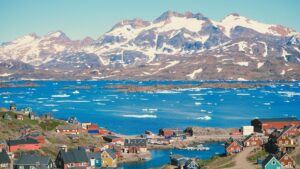Donald Trump has reignited his ambition to take control of Greenland. Trump has declared that the U.S. should claim the island autonomous territory of Denmark by diplomatic means or potentially by force. At a recent congressional hearing the island vast natural resources critical minerals, fossil fuels, and hydropower were highlighted. Experts did not discuss the significant environmental hazards that resource extraction would face exacerbated by human-induced climate change.
Extreme Climate and Challenging Landscape
 Greenland covered by an ice sheet up to two miles thick and home to about 56,000 people in frigid climate. Much of its coast remains frozen for large parts of the year. Historically Greenland climate has defeated numerous military and colonial efforts. During World War II, U.S military pilots often crashed onto the ice sheet due to fog and poor visibility. One of Greenland icebergs was responsible for sinking the Titanic in 1912, and in 1958, another iceberg destroyed a Danish icebreaker killing all 95 people aboard.
Greenland covered by an ice sheet up to two miles thick and home to about 56,000 people in frigid climate. Much of its coast remains frozen for large parts of the year. Historically Greenland climate has defeated numerous military and colonial efforts. During World War II, U.S military pilots often crashed onto the ice sheet due to fog and poor visibility. One of Greenland icebergs was responsible for sinking the Titanic in 1912, and in 1958, another iceberg destroyed a Danish icebreaker killing all 95 people aboard.
Rockslides and Tsunamis Threaten Coastal Settlements
The steep coastal fjords of Greenland, carved by glaciers, are prone to rockslides. In 2017, a mountainside in northwestern Greenland collapsed, falling 3,000 feet into a fjord. The resulting tsunami devastated the villages of Nuugaatsiaq and Illorsuit, destroying homes and killing four people.
Similar rockslide scars litter Greenland’s coast, with evidence of massive past events. One ancient rockslide filled the ocean with enough debris to fill over three million Olympic swimming pools. In 2023, another rockslide caused a tsunami that churned in a fjord for nine days.
For any resource extraction efforts, Greenland’s lack of infrastructure compounds the dangers. The island has no paved road network, making transport of heavy equipment and materials by sea the only option. Ports, docks, and facilities close to the water would be vulnerable to rockslide-induced tsunamis.
Melting Ice Complicates Resource Extraction
Global warming has accelerated the melting of Greenland’s ice, threatening both its natural environment and the infrastructure of its people. Native Greenlandic communities, long adapted to life with ice and snow, are struggling with record floods, which have washed away decades-old bridges and disrupted traditional transportation systems.
Melting permafrost frozen soil beneath the surface destabilizes the land and damages infrastructure. U.S. military installations in Greenland, such as runways and radar bases built during the Cold War, are now cracking and sinking as the permafrost thaws. This poses significant risks to operations at the Thule Air Base, a critical radar station for missile detection.
The increasing frequency of iceberg calving from glaciers also poses a danger to oil exploration. Large icebergs have been known to drift into the waters near Canada’s oil rigs, forcing emergency responses to tow them away. Despite these risks, Trump and his allies have expressed a desire to resume oil exploration in Greenland, ignoring the environmental hazards and high costs that have hindered past drilling attempts.
Sea Level Rise and Land Rebound
As Greenland’s ice melts and enters the ocean, sea levels around the world rise about one inch every six years in regions far from the island. However, close to Greenland, the land is rising instead. The massive ice sheet has long pressed down on the island’s rocky surface, and as the weight is removed, the land rebounds by more than six feet per century. This rapid rise could soon make some Greenlandic harbors too shallow for ship traffic.
Historical Failures and Future Warnings
History is filled with examples of failed colonial and military endeavors in Greenland. The Norse settlers abandoned the island 700 years ago, driven out by worsening climate conditions. American explorers and military bases on the ice sheet often succumbed to harsh weather or collapsing snow. The U.S. left behind abandoned bases and forced relocations of Greenlandic Inuit communities during the Cold War reminders of the island’s troubled past with foreign powers.
Trump’s desire to control Greenland appears similarly shortsighted. His focus on exploiting the island’s resources ignores the long-term risks posed by climate change. More significantly, the greatest value of Greenland may not be its resources, but its ice.
Global Impact of Greenland’s Ice Loss
Greenland’s ice plays a vital role in regulating the planet’s temperature. The ice reflects sunlight, helping to keep Earth cool. If Greenland’s entire ice sheet melts, global sea levels could rise by up to 23 feet. Such a rise would inundate coastal cities worldwide, causing economic losses in the trillions of dollars and forcing the largest migration in human history.
The ongoing threat of climate-driven sea level rise underscores Greenland’s global importance. Ignoring the risks posed by melting ice and natural hazards in Greenland not only endangers local communities but also threatens global stability. Any efforts to control or exploit the island’s resources without considering these realities are likely to court disaster.
